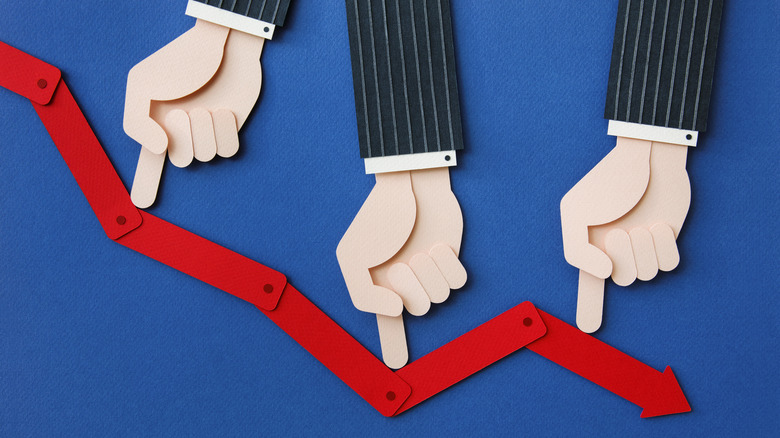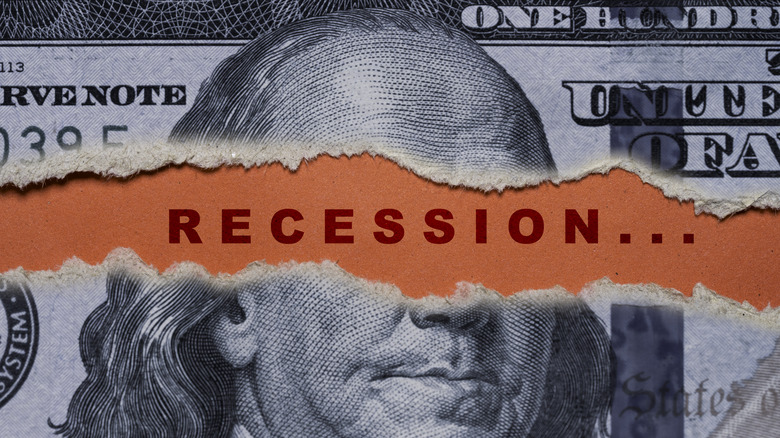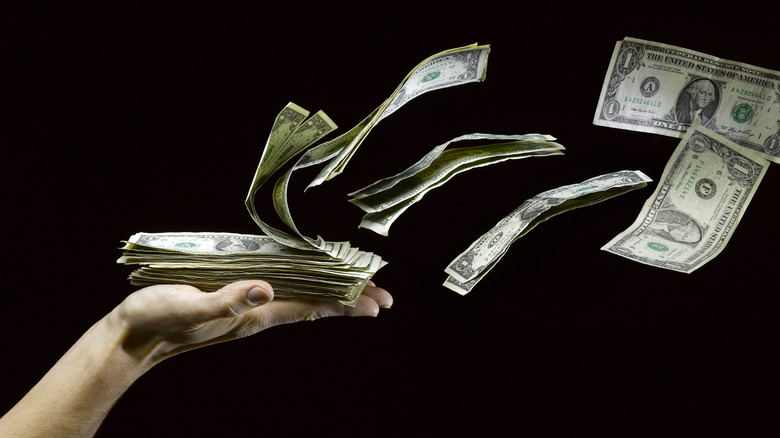The One Risk Factor That Would Prove March's Stock Market Dip Is Not A Buying Opportunity
One of the most commonly heard phrases in investing is to "buy the dip." This refers to the idea that when financial markets experience a significant drop in valuation, it presents a great opportunity to buy certain assets, given that the timing is right. Speaking of which, due to economic uncertainty in the U.S., the stock market has been experiencing a period of significant downturn. This has led many people to suggest that now is a great time to buy. However, there is one key risk factor you should consider before going on a buying spree. That is, of course, the idea that this current market pullback isn't going to lead to a recovery in the near future, but instead that the country is barreling headfirst into a recession.
At the same time, regardless of the economic situation, it feels as though there is always someone claiming a recession is imminent, and that you should pull your money out of financial markets and run for the hills. This being the case, how can you know for sure that a recession is or isn't in the cards for the near future? It's somewhat difficult to accurately predict, but there are reliable indicators you can use to gauge the likelihood of one — like the Sahm Rule. Applying these indicators to this recent market pullback is a good way to gauge whether now is indeed a great buying opportunity, or if a recession is on the way.
What is a recession?
In order to figure out if the U.S. economy is headed for a recession, it's important to understand what exactly a recession is and what happens during one. For starters, while it's most commonly viewed that a recession is a period of two consecutive quarters of negative GDP growth, this alone is not enough to definitively declare one. After all, we experienced this exact situation during 2022, and although it was a rough year for the U.S. economy, it was not officially deemed as a recession.
That said, in the U.S., recessions are officially declared by an organization called the National Bureau of Economic Research (NBER). They use three interchangeable factors in order to determine a recession: depth, diffusion, and duration. Depth refers to the severity of economic decline, diffusion refers to how widespread the decline is, and duration is obviously the length of time which the economic decline lasts. The last time the NBER declared a recession was in 2020 during the COVID-19 pandemic. This is because the U.S. experienced a 5.1% decrease in real GDP in the first quarter of that year, followed by a 31.2% decline in the second (depth). Outside of that, the unemployment rate was widespread across a multitude of industries during this period (diffusion), as it exploded from 3.5% in February 2020 to 14.7% by April 2020. However, the duration of this recession was only two months, effectively making it the shortest recession ever experienced in U.S. history.
Recession Indicators
Trying to predict a recession is rather difficult to do, but there are certain tools and data we can use to give us a better idea of what's coming. For starters, the Sahm Rule is an economic indicator which tracks unemployment numbers in the U.S. based on the 3 month unemployment rate average. It has been able to accurately predict nearly every single recession since 1950, well before the proper economic data has been available to do so. However, as of March, the Sahm rule shows a strong labor market, thus indicating a low likelihood of a recession in the near future.
Next, we have the yield curve inversion. The Federal Reserve Bank of Chicago defines this as when short term interest rates (2-year treasury securities) exceed long term interest rates (10-year treasury securities.) This causes a visible inversion on charts that measure the difference between the two, and in the past, has somewhat accurately predicted a recession within 6 to 18 months after the inversion. However, the most recent inversion began in October 2022 and ended in December 2024, and a recession has yet to happen. This is why some economists have criticized this as a reliable recession indicator. Outside of this, the most recent data from industrial production numbers, real personal income numbers, and real retail sales numbers do not indicate an imminent recession either. But if all of these indicators aren't ringing any alarm bells, then what's all the fuss about?
What to expect going forward
With so many conflicting opinions circulating on social media and the news, it can be hard for the average investor to make sense of what's going on — better yet how they should handle their investments. On one hand, you have the bears, who are suggesting a recession is imminent, the bull run is over, and that you should get out of the market while you still can. On the other hand, you have the bulls, who instead believe that this is just a brief period of uncertainty, the bull market is still on, and investors should take advantage of lower prices and buy the dip.
The truth is, it's all just noise. In reality, weak economic data and Donald Trump's proposed tariffs (as well as the ones already in effect) are largely behind both the negative price action we've seen in markets and recession fears. The reason for this is simple: weaker than expected economic data and tariffs bring economic uncertainty, and people (as well as financial markets) don't react well to uncertainty. Outside of that, based on the recession indicators discussed, there doesn't appear to be anything signaling one is coming in the near future. Still, with an abundance of economic uncertainty going on, it's rather hard to tell when exactly markets may turn around. Until there is more clarity and we receive some better economic data, economists are predicting a period of stagnancy as opposed to a full blown recession ahead.



